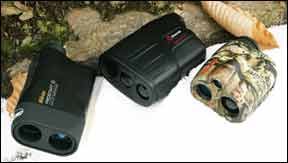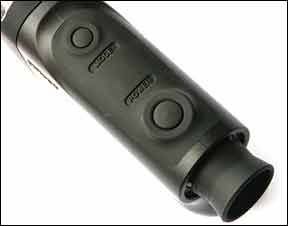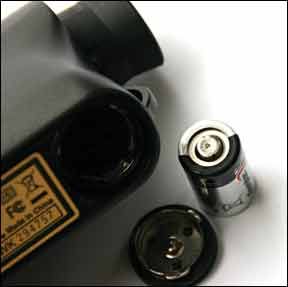It does not matter what type of implement you use – modern firearm, muzzleloader, or bow – determining distance to your target is critical. For a primitive-weapons hunter, it means waiting until the beast comes into range. For a user of modern firearms, it might mean dialing in exactly the right amount of hold-over – or passing up a shot – on a trophy thats at the edge of your ability to shoot accurately. One of the fastest, easiest to use, and affordable means of accurately gauging distance to various targets is a laser rangefinder. Laser rangefinders are basically a monocular that send out a pulsating laser beam that bounces off a target back to the unit and provides an instantaneous readout in yards or meters. The laser is similar technology to that used in autofocus cameras.

The price of rangefinders is directly attributed to the quality of electronics of the rangefinder. More expensive rangefinders have lasers with less beam divergence, which is when the laser-beam diameter begins to spread out over distance. Instead of a tight, narrow beam, the beam becomes wider, like a cone, at the target end of the beam. The more beam divergence, the less accurate the distance reading. Those more expensive rangefinders also have more added features like a ballistic calculator, modes for use in rain or snow, different reticle choices, can range at farther distances, to name a few.
We recently tested three affordable laser rangefinders with similar maximum distances and features. The Nikon ProStaff 3 No. 8390, Simmons LSF 600 No. 801405, and Redfield Raider 550 No. 67445 are all bare-bones models that only provide distance readings, though the Simmons LRF 600 has what Simmons calls Tilt Intelligence. All of these rangefinders tout their long-distance measuring capabilities, and the three we tested all say they range out to about 550 yards (Redfied and Nikon) or 600 yards (Simmons), but that capability depends on the targets reflectivity.
The targets reflectivity determines how well the rangefinder will work. Hard reflective surfaces, like a rock or vehicle, are very reflective, while soft targets, like the fur of an animal, are less reflective. Laser rangefinders can also provide false readings from ground scatter or beam interference. Some rangefinders can become confused. When a target is partially obscured by terrain features, the pulsating laser beam may distance the brush instead of the deer standing behind it. False readings can also be caused by heavy rain and snow. We were fortunate to test in light rain and in heavy snow as well as on whitetail deer in dense mountain laurel. In mountain laurel you typically see only a portion of a deer, so it was a good test of the units ability to range in heavy cover.
The rangefinders designs were slightly different. The Nikons top objective lens is where a user views a target and where the laser is emitted. Under the objective lens is the laser detector aperture, where the bounce back of the laser is captured by the unit. The Redfield and Simmons used a set up with three lenses: an objective lens for viewing the target, a lens to emit the laser, and one to detect the laser bounce back. On the Simmons, the lenses were stacked vertically. The Redfield tucked the laser lens between and to the left of the objective and detector aperture.
The Nikon ProStaff 3 was the only rangefinder of the three tested that stated it was waterproof, the others did not, so to keep the playing field level we only sprayed each rangefinder with water and found each worked perfectly well after getting wet. No moisture was detected inside any of the rangefinders. From the freezer we found that they all fogged equally and took about 15 minutes to clear completely and operate properly. Dropping the rangefinders from a height of 36 inches onto plywood showed no adverse effects. Where we began to see differences was in brightness, image and color clarity, ranging and ergonomics.
All the units needed to be turned on prior to ranging. Press the power button once, then aim the reticle at the target and while holding the reticle on target, press the button again for the distance to be displayed. The LCD display was black in all models, and at times the reading was lost if the target was against a dark color. All three units also had a lanyard loop and a nylon carrying case.
At a pistol range (15, 25, and 50 yards) and rifle range (100 and 200 yards) we tested all three units with known measurements and found all units varied, on average, +/- 1 yard, which is well within the manufacturers specifications and not much of an issue when targets are under 200 yards. But it is something to keep in mind as you push the limit of the rangefinder and your ability to shoot accurately at distance. A whitetail deer at 200 yards is a small target, and placing the rangefinders reticle on the target and activating the rangefinder can be tricky. As you depress the activation button, the rangefinder must be kept steady or you might accidently jar the unit by pressing the button and accidently range the clump of grass in front of that deer.
We also found that some units were easier to use at faraway targets. The Nikon and the Simmons had the easiest button to push. It barely took any pressure, and this was a plus. The Redfield required slightly more effort to press. We found that taking multiple readings was the best practice to ensure we were truly ranging the intended target. This may sound time consuming, especially with an itchy buck ready to bolt, but the rangefinders operate almost instantaneously.

At greater distances, targets like deer are smaller and more difficult to range. A users ability to range, say a deer, at the outer limit of each of the rangefinders is questionable since the magnification was only 4x (Simmons) and 6x (Nikon and Redfield). So it can be difficult to find a target. In low-light, all units rated fair since they did not have the light gathering ability you expect in a riflescope or binoculars.
Though the Simmons states it has a 600-yard maximum range, its manual reads the maximum distance for most objects is 400 yards. Redfields manual also states a deer-sized animal can be ranged out to 400 yards yet it is specified to range at 550 yards. All three manuals state that the respective units obtain the best results on highly reflective targets and targets that are orientated perpendicular to the user.
We tested the units in an open area where we had unobstructed views and no brush to interfere. On small outbuildings and vehicles, the units performed to their maximum distance; on less reflective targets like trees and animals, the units performed only at lesser ranges. It all depends on lighting and reflectivity, but we averaged about 400 yards, +/- 10 yards, on less reflective targets. Past this distance on less reflective targets, ranging was difficult.
Nikon ProStaff 3 No. 8390, $180
The Nikon ProStaff 3 (MidwayUSA.com #698417) is held vertically in the hand, like all three models tested. It felt thin to testers yet was the largest of all the rangefinders. A battery was included with the Nikon and Redfield. The Nikon was easy to operate, as were the others, with either the right or left hand.
The eyepiece was adjustable, so all testers could focus the unit. The eyepiece also had a flip-up rubber eyepiece for those who wear eyeglasses. The Redfield also had the flip-up rubber eyepiece. The Simmons did not. When viewing through the unit, an icon indicating battery life showed below the reticle. Above the reticle was the distance display. To range, the shooter presses the activation button, acquires the target in the reticle, and presses the button again. The reticle for the Nikon was the easiest to pinpoint on the target because it used a traditional crosshair. When the laser was activated, an X appeared with the center open so the target was not obscured. If the unit was unable to range a distance, three dash marks appeared in the distance display, which told the user to press the activation button again.

The electronics in the ProStaff 3 features a Distant Target Priority System that defaults to the most distance target. For instance, if a tree is 100 yards, a bush 110 yards, and a deer 125 yards, the unit will range the farthest target – in this example, the deer. We tested this feature with rocks, trees, and bushes and we were able to better zero in on our intended target because of the reticle. The Nikon also had a scan mode, as did the Redfield, that allowed a user to hold down the activation button and scan targets with instant readings. You could scan continuously for only 20 seconds at a time, then you needed to release and re-press the button to range again.
Our Team Said: The Nikon ProStaff 3 was large and testers preferred the more compact models. The two buttons on the top were confusing at first until testers were acclimated. The reticle was very precise, which some testers liked, but it did obscure smaller targets, which testers did not like. The reading display was above the reticle, which was faster for users to read. The scan function was annoying to some users who wanted to scan for more than 20 seconds.
Simmons LRF 600 No. 801405, $155
The view through the Simmons LRF 600 (CheaperThanDirt.com #3-0929461) was the clearest and brightest of the three units. It lacked an eyepiece adjustment and did not have a scan mode. The reticle was different from the other two units. It was small and rectangular in shape.
To use the Simmons, first press the activation button to turn on the unit. Make sure the target is inside the rectangle, press the activation button, and at the four corners of the rectangle the legs of an X appeared, telling the user the laser was activated and distance measurement appeared under the reticule. To change from meters to yards, the activation button is held down for 5 seconds, and you can toggle between U.S. or Metric units. A battery icon in the display indicates remaining battery life. The Simmons automatically turns off after 30 seconds. All the rangefinders did turn off automatically, some turned off quicker like the Nikon, which switched off after 8 seconds.
The LFR 600 did not have a scan mode, but it did have Tilt Intelligence, which calculates the elevation angle to provide a true horizontal distance, but only up to a distance of 100 yards. Past 100 yards, it automatically turns off. As an example, a deer is ranged at 50 yards but because you are uphill or downhill from the deer, the unit calculates the angle-range-compensated distance, which is displayed under the line-of-sight distance. This helps you from shooting over or under the deer. Light rain did not appear to affect the reading from any of the three units. In tight places where only a portion of a deer could be seen, we ranged the Simmons multiple times because brush was picked up instead of the intended target.
In more open terrain, the reticle seemed easier to use. The scan mode was helpful in times like these as the button on the Nikon and Redfield could be held down and all the surrounding area could be ranged, so we could tell when a bush was ranged and the target. With the 4x magnification, the LRF 600 had a wider field of view than the 6x magnification of the Redfield and Nikon, though testers seemed to prefer the slightly higher 6x magnification. The 9-volt battery was not included, which seemed a miss by Simmons.
Our Team Said: Testers liked the fact the LFR 600 used a 9-volt battery, as these batteries are very easy to obtain. They did not like that the unit lacked a scan mode and eyepiece adjustment. It did feel good in hand and operate better, because the larger reticle seemed more forgiving than the other units more precise reticles. At times the reading display took slightly longer to read when ranging targets with dark backgrounds. The clarity and cost kept the rangefinder in contention, as did the built-in angle-range-compensated-distance feature.
Redfield Raider 550 No. 67445, $190
The Raider 550 (CheaperThanDirt.com #2-RF67445), unlike the other units, has a simple crosshair reticle. The distance displayed above the reticle, while the battery-status indicator was below the reticle. In scan mode, the user could continuously measure distances for as long as he liked. This was the most compact model, and those with large hands in bulky gloves will need to be sure they do not accidentally cover the laser aperture. The only indication in the display that indicated the unit was ranging was the three vertical dashes in the distance display area. If a distance could be ranged, it was displayed; if not, three horizontal dashes appeared. Most testers liked this simplicity. We found that in brushy terrain, all the laser rangefinders accidently picked up branches, so you need to take a few more readings to be sure you are reading the proper distance. In a heavy snow, all three rangefinders ranged incorrect distances. Our 35-yard test tree ranged in snow anywhere from 8 yards to 21 yards as the beam was bouncing off the snow and not the tree.
Our Team Said: The Raider 550 was small and compact, which testers liked. The simple reticle and reading display above the reticle made this the rangefinder testers most liked to use.
Written and photographed by Robert A. Sadowski, using evaluations from Gun Tests team testers. GT






























